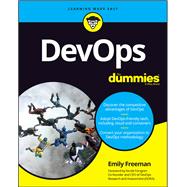Develop faster with DevOps
DevOps embraces a culture of unifying the creation and distribution of technology in a way that allows for faster release cycles and more resource-efficient product updating. DevOps For Dummies provides a guidebook for those on the development or operations side in need of a primer on this way of working.
Inside, DevOps evangelist Emily Freeman provides a roadmap for adopting the management and technology tools, as well as the culture changes, needed to dive head-first into DevOps.
- Identify your organization’s needs
- Create a DevOps framework
- Change your organizational structure
- Manage projects in the DevOps world
DevOps For Dummies is essential reading for developers and operations professionals in the early stages of DevOps adoption.









